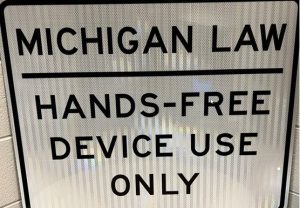Michigan’s hands-free law took effect on June 30 which means all vehicle drivers are prohibited to hold or use a cellphone while driving except for emergency calls, cell phone mounts, and connecting a cellphone via Bluetooth dashboards to use a single-touch hands-free program.
The hands-free law is meant to prevent distracted driving, which is the leading factor in most crashes and near-crashes.
Informing youth about the dangers of distracted driving, especially when it comes to using a cell phone or other mobile electronic device is important. While Kelsey’s law made it illegal for teen drivers to use a cell phone while driving when it was voted into law in 2012, it is still important for youth to understand the dangers of distracted driving and the new law as it will pertain to them when they turn 21.
What does the hands-free law say?
The law says1 that drivers cannot hold or support a phone or other device with any part of their hands, arms, or shoulders while driving or when stopped in traffic. Even if their phone is mounted on their dashboard or connected to their vehicle’s built-in system, they cannot use their hands to operate it beyond a single touch. That means they cannot manually do any of the following on their phone or other device while driving:
- Make or answer a telephone or video call.
- Send or read a text or email message.
- Watch, record, or send a video.
- Access, read, or post to social media.
- Browse or use the Internet.
- Enter information into GPS or a navigation system.
The law makes holding or manually using a cell phone or other device while driving a primary offense, which means an officer can stop and ticket drivers for this violation.
What are the penalties?
If drivers break the law, they could face the following penalties :
- 1st violation: $100 fine and/or 16 hours of community service.
- 2nd or subsequent violations: $250 fine and/or 24 hours of community service.
- 3 violations within a 3-year period: Complete a driving-improvement course.
If drivers cause a crash while holding or manually using a mobile device, any civil fines will be doubled.
How can drivers avoid breaking the law?
To avoid breaking the law, drivers must go hands-free. If the driver needs to use technology, use hands-free technology such as Bluetooth or integrated systems within the vehicle as long as it does not require manual use. Anything more than a single touch to a device is against the law. Drivers can also use voice-activated commands to make calls, send texts, play music, or get directions through the vehicle’s integrated Bluetooth system. If they need to use the device is needed for something else, the driver should pull over at a rest area or safe and legal parking space to interact with their device.
The only exception to the law is that drivers may call or text 911 to report an emergency or seek help.
Why is this law important?
This law is important because distracted driving is dangerous and deadly. According to the National Highway Traffic Safety Administration (NHTSA), in 2021, distracted driving killed 3,522 people in the U.S. By going hands-free, drivers can reduce distractions and focus on the road. The law is designed to protect the driver, their passengers, and those with whom they share the road.
What can parents and schools do to spread the word?
Spread the word about the new law by talking to youth about the law and what it means for safety. Share this article via email, social media, or if you are a teacher, send a printed copy home with your students. Consider joining campaigns like It Can Wait or End Distracted Driving that raise awareness and educate people about the dangers of distracted driving.
Remember, your phone can wait. Your life can’t. Go hands-free. Just drive. It’s the law.

